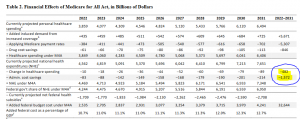An Aug. 3, 2018 PolitiFact fact check of Sen. Bernie Sanders (I-Vt.) on Medicare For All helps show the disadvantages of issuing fact check ratings without the benefit of logic. PolitiFact’s system ends up giving a “Half True” rating to Sanders’ entirely spurious argument.
PolitiFact quotes Sanders to introduce his argument:
Sanders said, “Let me thank the Koch Brothers of all people for sponsoring a study that shows that Medicare for All would save the American people $2 trillion over a 10-year period. … That is what is in the study of the Mercatus Center.”
PolitiFact’s fact check goes on to say “In a way, Sanders is right, though his assertion glosses over some caveats.”
PolitiFact and Sanders Both Wrong
Sanders and PolitiFact both err in saying the Mercatus study shows that Medicare For All would save the American people $2 trillion.
PolitiFact:
The Mercatus report included a table summarizing the financial effects of Sanders’ bill. With a minimum of arithmetic, it’s not hard to find the $2 trillion in question.
It’s the difference between the Department of Health and Human Services’ projection of the amount of total health care spending in the United States, and what Mercatus thinks that number would be under Sanders’ Medicare for All proposal. (See Table 2.)
PolitiFact’s hotlink through the “Department of Health and Human Services’ projection” does not lead to a projection at all, so far as we can tell. It leads to a document titled “National Health Expenditures 2016 Highlights.” We find the title fitting. The three pages describe various aspects of health expenditures in 2016, and the word “projection” does not occur.
Working just from Table 2 of the Mercatus paper by Charles Blahous we believe we reconstructed the method PolitiFact used (see image below). The two numbers we highlighted in yellow add up to -2,054.
PolitiFact reported “Specifically, total health care expenditures would fall by $2.054 trillion over 10 years, according to Mercatus.” Our number matches PolitiFact’s after appropriate movement of the decimal, so we assume that we understand PolitiFact’s backing for its claim.
But PolitiFact and Sanders misrepresent what the paper says. Table 2 does not express Blahous’ view of the likely result of the Medicare For All proposal. Instead, it represents a conservative (read: low) estimate of the expense of Medicare For All. The paper uses the conservative estimate as a point of comparison for predicting higher costs.
The clues from the paper were hard to miss.
The Abstract (bold emphasis added):
The leading current bill to establish single-payer health insurance, the Medicare for All Act (M4A), would, under conservative estimates, increase federal budget commitments by approximately $32.6 trillion during its first 10 years of full implementation (2022–2031), assuming enactment in 2018. This projected increase in federal healthcare commitments would equal approximately 10.7 percent of GDP in 2022, rising to nearly 12.7 percent of GDP in 2031 and further thereafter. Doubling all currently projected federal individual and corporate income tax collections would be insufficient to finance the added federal costs of the plan. It is likely that the actual cost of M4A would be substantially greater than these estimates, which assume significant administrative and drug cost savings under the plan, and also assume that healthcare providers operating under M4A will be reimbursed at rates more than 40 percent lower than those currently paid by private health insurance.
On Page 3 Blahous explains that Table 2 represents a ground floor estimate–a lower boundary (bold emphasis added):
It is likely that the actual cost of M4A would be substantially greater than has been estimated from its legislative text. That text specifies that healthcare providers including hospitals, physicians, and others will be reimbursed for all patients at Medicare payment rates, which are projected to be roughly 40 percent lower than those paid by private insurers during the first 10 years of M4A’s proposed implementation. By assuming these payment reductions will be implemented and sustained, these cost estimates essentially represent a lower bound. To ease the interpretation of these estimates, the following simplification of the calculations is provided in table 1, using the year 2022 as an example. Table 2 (page 7) provides further details of the 10-year estimates.
Sanders wrongly treated the described lower boundary as Mercatus’ expectation for the Medicare For All proposal.
On Aug. 5, 2018 on C-SPAN Blahous addressed the notion that his study showed Medicare For All would save $2 trillion in health care costs:
I would caution about the interpretation that some have put forward that my study shows total national health care spending going down under Medicare For All. That’s actually not what it says. Uh, What my study says is that additional spending that would arise from expanded coverage, uh, not only covering for the uninsured but expanded utilization by people that already have insurance, would be much greater than the potential savings from the administrative costs or even the very aggressive reductions in drug prices.
Assuming the Medicare For All bill could stick to the current-law schedule for Medicare reimbursement accounts for the savings found for the conservative estimate. But Blahou’s paper points out such expectations are unrealistic.Current Medicare rates would likely chase providers out of the market. Unless the government adopts higher reimbursement rates the delivery of health care services might decrease under a Medicare For All plan. The expected higher reimbursement rates would easily wipe out the savings suggested by the conservative scenario.
PolitiFact Misrepresents
PolitiFact more-or-less followed Sanders’ lead in presenting the conservative estimate as a finding of the Mercatus paper:
- “The Mercatus report included a table summarizing the financial effects of Sanders’ bill”
- “Under Mercatus’ projection for Medicare for All, the total amount of health expenditures would actually fall …”
- “Specifically, total health care expenditures would fall by $2.054 trillion over 10 years, according to Mercatus”
PolitiFact repeatedly presented the lower boundary estimate as Mercatus’ expectation for the Medicare For All expansion.
Near the end of its fact check PolitiFact noted Blahous’ objections to presenting the conservative estimates as Mercatus’ projection for the bill. And at that point PolitiFact started referring to the conservative estimate as one of two alternative scenarios.
However, in an alternative scenario in which cost-control works less effectively (see Table 4) Mercatus found that over the same 10-year period, national health expenditures would actually increase by $3.252 trillion compared to current law.
So while the number Sanders chose really does appear in the report, he’s cherry-picked the more flattering of two estimates.
Contrary to PolitiFact’s framing, the conservative estimate exists in the paper as the rose-colored-glasses scenario. What PolitiFact calls “the more flattering of two estimates” is one that Blahous describes in the paper as unlikely. Sanders and PolitiFact mislead their audiences by implying that the conservative estimate represents Mercatus’ prediction for a Medicare For All bill.
PolitiFact only slightly mitigates Sanders’ error by turning the estimate Sanders touted into “the more flattering of two estimates.”
Sanders falsely portrayed Blahous’ unlikely scenario as confirming Sanders’ expectations. Blahous’ paper did nothing to confirm the conservative estimate Sanders’s trumpeted. Instead, the purpose of the paper was to emphasize that the rosy scenario was not likely to occur.
PolitiFact continued to portray the conservative estimate as a realistic expectation described in Blahous’ paper, though merely one of two.
Neither scenario was intended as realistic.
In fact, Blahous’ supposed estimate showing the $3.252 trillion cost increase came from another unlikely assumption, that the government would reimburse health care costs at their current rates instead of the austere Medicare schedule called for the Medicare For All proposal. Blahous’ paper implies that the true costs will fall in between those listed in the two scenarios. PolitiFact’s reporting offers its readers no clue regarding that implication.
What Do Circular Arguments Show?
In logic, a circular argument has the conclusion contained in a premise. In effect, Sanders employed the Mercatus study as part of a circular argument supporting his Medicare For All plan.
Blahous assumed for the sake of his conservative projections that provisions of the Medicare For All plan would essentially work as advertised. Sanders used the figures Blahous produced based on those assumptions as a confirmation of the truth of the assumptions. That type of spurious logic cannot properly earn a “Half True” rating according to PolitiFact’s definition.
Circular arguments prove nothing. The assumption that X will occur remains an assumption in a circular argument and the probability of X occurring does not increase no matter how often the circle repeats.
Wouldn’t it be nice if fact checkers understood such concepts?
A Zebra Fact Check evaluation of Sanders’ claim would have noted that Blahous did not “show” that Medicare For All would produce the savings Sanders claimed, making Sanders’ statement false. And it would have included a fallacy icon to help explain to interested readers the huge basic problem with Sanders’ argument.
![]()
PolitiFact’s fact check misrepresents the gist of Blahous’ paper and fails to pinpoint Sanders’ central error. Sanders was wrong, not “right in a way.” PolitiFact used Table 2 of the report out of context to communicate a misleading impression.
We encourage PolitiFact to correct its fact check.
Note: Our ongoing thanks to the folks at YourLogicalFallacyIs.com for permission to use their set of fallacy icons.




